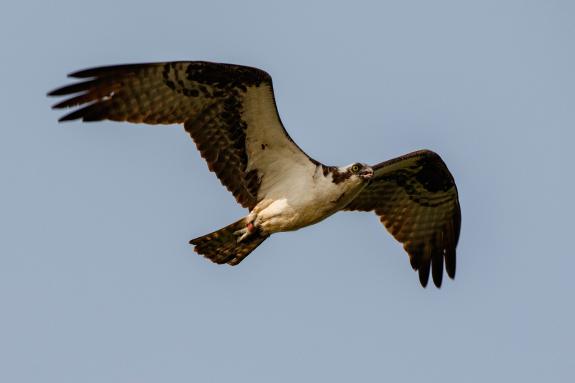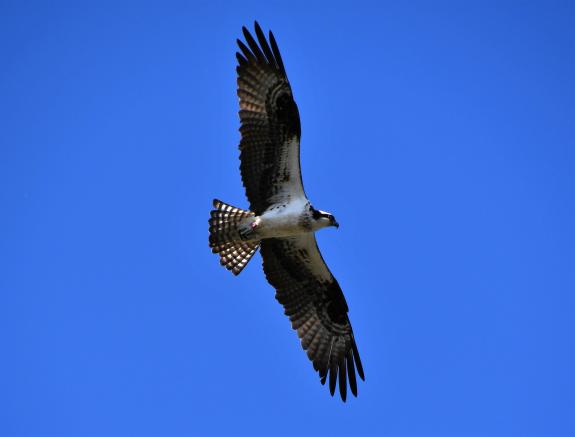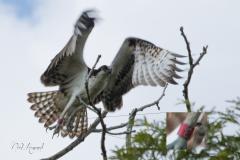Project RedBand
A citizen-science based banding and re-sighting project on Barnegat Bay that is menat to engage locals and visitors to the New Jersey coast in osprey management and conservation.
 Elite red banded osprey, 20/H is photograped with prey in Oceanport, NJ in April 2020. She was banded as a nestling in July 2017 at Sedge Island WMA. John Bacaring
Elite red banded osprey, 20/H is photograped with prey in Oceanport, NJ in April 2020. She was banded as a nestling in July 2017 at Sedge Island WMA. John Bacaring
Ospreys have made a remarkable recovery in New Jersey. Over the past 40 years we have seen the population grow from only 53 pairs in 1973 to over 700 in 2022! Over that same time funding needed for their management has declined. Today their population is not in jeopardy of being extirpated as it was in the early 1970s. As funding is being directed towards species that are in decline, we move to utilize our citizen scientists and volunteers to help monitor and manage the population.
To help engage citizen scientists and for the first time in over 20 years, young ospreys have been marked with an auxiliary band in New Jersey. The new band, which is a red anodized aluminum rivet band bears an alpha-numeric code. This allows birders, osprey watchers and wildlife photographers the ability to identify these individual birds by their bands -- when they are alive!
This new project is being focused on ospreys that nest in the Barnegat Bay watershed from Point Pleasant south to Little Egg Harbor. The main goals of the project are to engage the public in osprey management and conservation along the Jersey Shore. At the same time, while collecting data from re-sightings, we will learn about their dispersal, foraging habits, site fidelity, migration routes, and their life span.
All auxiliary banded osprey in NJ wear the red band on their right leg.
In addition to banding young, we will be developing educational and interpretive materials to spread word about Project RedBand, ospreys and their importance in the coastal ecosystem.
In 2014, during osprey nesting surveys, a total of 63 red bands were deployed on young ospreys. The young were banded at their nest sites (see map below) before they could fly, in late June and early July. Once airborne, the young can be re-sighted as they learn to hunt, soar, and eventually migrate south for the winter. Once they reach their wintering grounds in the Caribbean, Central America, and with largest concentrations in N. South America they will remain there for the next two years (will return to New Jersey at the earliest in 2016).
All banding, marking, and sampling is being conducted under a federally authorized Bird Banding Permit issued by the U.S. Geological Survey’s BBL.
Band Information for re-sightings:
 Zoom+ One of the last auxiliary banded osprey of 2014 was 61/C who was produced at a nest off High Bar. You can read a story about her on Readings from the Northside.
Zoom+ One of the last auxiliary banded osprey of 2014 was 61/C who was produced at a nest off High Bar. You can read a story about her on Readings from the Northside.
Sequence: Red with codes 00-100 over capital “C” (2014-2016) and "D" (2016). All aux. birds banded in NJ wear a silver USGS band on their left leg and a red band on their right leg.
(NOTE: Red bands were deployed in PA years ago and might be with the sequence 00-99/A-B.)
Bands deployed in 2014: 00/C to 62/C were deployed in 2014. Two of those bands were already recovered: 30/C and 31/C (who were blown from their nests at Sedge Islands WMA in late July). #62. 53/C was recovered after being electrocuted in spring 2016 in Forked River.
2015: 63/C to 97/C (93/C was destroyed). #33
2016: 98/C, 99/C. 00/D - 59/D #62. Band 39/D has already been recovered (dead).
2017: 60/D - 99/D. 00/H-65/H #106.
2018: 66/H - 99/H and 00/K - 30/K. #66
2019: 31/K - 99/K (42/K was destroyed). #68
2020: 00/M - 55/M (not 06/M) - 02/M did not survive to fledge (eye punctured on nest and euthanized by TriState Bird Rescue - 6/20) - #55
2021: 56/M-98/M (not 59/M, who was recovered deceased beneath nest post-banding).
2022: no ospreys were banded with red aux bands. Band 99/M has not been used. More detailed re-sightings and encounters will be published in our annual report.
2023: We were able to obtain more red aux. bands this year and deployed #77 from 99/M, 00/N-76/N at nests on Barnegat Bay.
Total Deployed: #576
Additional re-sighting information desired:
- Date
- Time
- Location (GPS coordinates if possible)
- Closest town
- Aux. Red band code
- Bird behavior (resting, perched, feeding (if eating, prey species ID), hunting-foraging, hovering, soaring, flight-high, flight-low, other-please note)
Re-sighting confirmation: Photos of red banded ospreys are in some cases critical to confirm your sighting. If possible, please try to get a high resolution photo of the band.
>>Click here to access a Google Form to report your re-sighting of a red banded osprey.
Special thanks to Northside Jim and all the readers from "Readings From The Northside" for helping to make this project possible. Their enthusiastic support for conserving New Jersey's ospreys is unparalleled! Thank you!! :)
NEWS and Red Band sightings!
August 2023
Thankfully, we were able to get in touch with the company who produced red bands since we began banding ospreys with red aux. bands in 2014 and were able to get more to use this year. The number of aux. band encounters has been amazing, which helps us to learn more about the lives of our ospreys who originated from nests on Barnegat Bay. The new bands deployed this year were 99/M, 00/N - 76/N. We will have full results in our annual report, but so far these red bands have been encountered this year: 63/K, 27/H, 41/M, 63/C, 95/M, 27/H, 40/M, 49/M, 21/K, 11/M, 60/H, 23/C, 65/D, 32/H, 74/D, 97/K, 63/C, 15/H, 61/H, 44/D, 26/K, 67/C, 54/D, E/37 (green band, NY), 00/C, 97/M, 43/H, 21/N, 91/M, 89/D, 11/H, 69/K, 72/N (found dead under natal nest in Holgate).April 2020
I know it's been a while since my last update on re-sightings of red banded birds. We haven't received many until just a few weeks ago. Here are some re-sightings that we've received (photos will follow in text afterwards).
12/H - Banded 7/8/17 at nest 123-A-014. Sedge Island. Re-sighted in February in Colombia. Bird reportedly starved to death.
90/C - Male. Banded 7/13/15 at nest 123-A-018. Sedge Island. Re-sighted by Barnegat Light Osprey Cam on 3/31/20.
41/H - Female. Banded 7/9/17 at nest 123-A-004. Sedge Island. Re-sighted perched along GSP in Port Republic by Adam Cannizzaro on 3/30/20.
79/D - Female. Banded 7/5/17 at nest 135-A-022. LBIF. Re-sighted 4/3/20 by Ken Ostrom in Oceanport. This is the third time 79/D has been re-sighted (Florida-9/7/17 & Bayville-5/15/19).
67/C - Male. Banded 6/25/15 at nest 135-A-032. LBIF. Re-sighted at nest 123-A-030 @ Sedge Island on 4/7/20.
65/D - Female? Banded 6/26/17 at nest 147-B-036. Marshelder Island, off LBI. Re-sighted at BL Osprey Cam on 4/17/20 by viewer Ken Ostrom. Video.
44/C - Male. Banded 7/12/14 at nest 123-A-021. Sedge Island. Re-sigthed on 4/19/20 by Rich Baumann in Bayville. We suspect this male is nesting somewhere and hope to pinpoint location this summer. NOTE: 44/C has been re-sighted in the past at IBSP by photog Shayna M. in July 2016.
20/H - Female. Banded 7/9/17 at nest 123-A-010. Sedge Island. Photographed and re-sighted by John Bacaring in Oceanport on 4/21/20.
16/M - Sex unknown. Banded 7/3/20 at nest 135-A-032, near LBI. Found dead on 9/27/20 in Springfield, Virginia. Cause of death is unknown. Bird was found in good condition in a residential area.
July 2019
This summer we confirmed the first breeding red-banded osprey at Sedge Islands! On July 9, while surveying a nest with Sedge Island staff and campers, we observed a red band on the breeding male. The nest is located right behind the Sedge House and is one that we installed in 2014 for a pair that was attempting to contruct a nest on the Sedge House. 39/C was banded as a nestling on July 12, 2014 at nest #2886 which is only .94 miles from where he now nests! This is really exciting news, since we have not obtained any re-sightings of a red banded bird who is now nesting as an adult.
 39/C as he flies from his nest and over us at Sedge Island on July 9, 2019. Ben Wurst
39/C as he flies from his nest and over us at Sedge Island on July 9, 2019. Ben Wurst 39/C and his mate perched on a nearby tree. Ben Wurst
39/C and his mate perched on a nearby tree. Ben Wurst
Another re-sighting of a red banded osprey came in from John J Burke, who captured images of an adult female who has a red band at the Spring Lake NJ Transit Train Station (where there is a nest on a tall platform) on June 15-16.
From John "One of a pair flying above the nest at the Train Station. The nest was occupied and the Osprey in the nest was very vocal. I have a picture of the osprey. The band is hard to read."
With John's observation, this likely means that this red banded bird was not one of the breeding pair since one of them was "on the nest and very vocal." The full band is hard to read but it looks like --/D. Hopefully she will settle down and we can ID her! Thanks for your sighting, John!
 --/D photographed in mid-June in Spring Lake, NJ. John J. Burke
--/D photographed in mid-June in Spring Lake, NJ. John J. Burke
April 2018
Osprey 04/D was re-sighted and photographed in Allendale at the Celery Farm. She was banded as a nestling on 7/1/16 at a nest off LBI. You can read more about her and her re-sighting on our blog. In other news, we ordered another 100 red bands to deploy this year and hope to beat our 2017 record of 106 birds banded.
August 2017
We banded more young ospreys with red bands this year than any other year. The main reason for this was ideal weather conditions which did not limit surveys. A total of 106 young were banded this year from as far north as Mantoloking to Beach Haven. At several nest sites, if young were too young to band at the first attempt, we made plans to visit a second time so that they could be part of this elite group of young ospreys.
This year, on June 30, we banded two young ospreys (76/D & 77/D) live on Facebook at a nest inside Island Beach State Park. The nest has a webcam which is operated by the Friends of Island Beach State Park. The banding was viewed over 15,000 times! We're excited for more opportunities like this to be able to teach others about the importance of monitoring wildlife, like ospreys, who are bioindicators for the health of our aquatic environments.
In other news, osprey 78/D "Chump" was found down on the ground near its nest at LBIF on July 30. Chump was rescued by local citizens and successfully rehabilitated by Don Bonica of Toms River Avian Care. We released Chump back at LBIF on August 24.
August 2016
We are sad to report that 39/D, an osprey nestling that we rescued and banded, as part of this project was found dead only 12 days after he was rescued. He was found under a utility pole that was on the bay and only 700' from his nest. We are working with JCP&L to fix the problem and make sure other poles are more avian friendly to prevent this from happening in the future.
July, 2016
44/C
July 15, 2015
 Zoom+ An osprey nestling is banded (76/C) with a red auxiliary band at a nest behind the Long Beach Island Foundation of Arts and Sciences. So far we have deployed 30 red bands in 2015. Ben Wurst
Zoom+ An osprey nestling is banded (76/C) with a red auxiliary band at a nest behind the Long Beach Island Foundation of Arts and Sciences. So far we have deployed 30 red bands in 2015. Ben Wurst
Osprey nesting surveys are wrapping up on all areas, including Barnegat Bay. So far this summer we have deployed 30 red bands. We have 8 more bands to deploy and we are hoping to get out to a few more nests to deploy the rest of them.
June 23, 2015
04/C is a photo friendly bird! I just came across this photo of him, taken by a local photographer Eric Hance back in August 2014.
December 9, 2014:
04/C who originated at a nest on Long Beach Island was re-sighted on the Caribbean island of Trinidad and Tobago on Dec. 5th. Nicholas H., who spotted the young male osprey was able to capture a photo of 04/C when he took off. From the photo he was able to read the band and submit an observation of the osprey. This is really a remarkable find and an awesome report for us to get.
 Zoom+ On December 5th, 04/C was photographed on his wintering grounds of Trinidad and Tobago. He originated at a nest on Long Beach Island where he was banded with his two siblings, 05/C and 06/C. Ospreys spend their first two winters in their wintering areas. They learn the best foraging areas and will return to these same areas for the rest of their lives! © Nicholas Hassanali
Zoom+ On December 5th, 04/C was photographed on his wintering grounds of Trinidad and Tobago. He originated at a nest on Long Beach Island where he was banded with his two siblings, 05/C and 06/C. Ospreys spend their first two winters in their wintering areas. They learn the best foraging areas and will return to these same areas for the rest of their lives! © Nicholas Hassanali
We deployed a total of 61 red bands (00/C to 62/C) this summer, so having one re-sighted on their wintering grounds is like finding a needle in a haystack! I'm also really glad that Nick was even able to find our website here to be able to report the red band to us. The stars aligned for this awesome sighting to come in! --Ben
Media Features:
- September 3, 2014 - Cover photo and inside page spread
- Aug 8, 2014 - Readings from the Northside - Red bands on the move!
- Aug 9, 2014 - Readings from the Northside - Osprey 61/C
- July 24, 2014 - Readings from the Northside - Project RedBand is a go!
- July 16. 2014 - Readings from the Northside - Osprey thunderhead
- July 9, 2014 - Readings from the Northside - Osprey Maniacs
- July 12, 2013 - Readings from the Northside - We got our bands
Additional links:
- Learn about the New Jersey Osprey Monitoring Project
- View all nests in New Jersey
- Watch as we band young during a nesting survey at Edwin B. Forsythe NWR
- Follow ospreys on migration!!
Contact Us:
Ben Wurst, Senior Wildlife Biologist: Email
Find Related Info: Osprey





